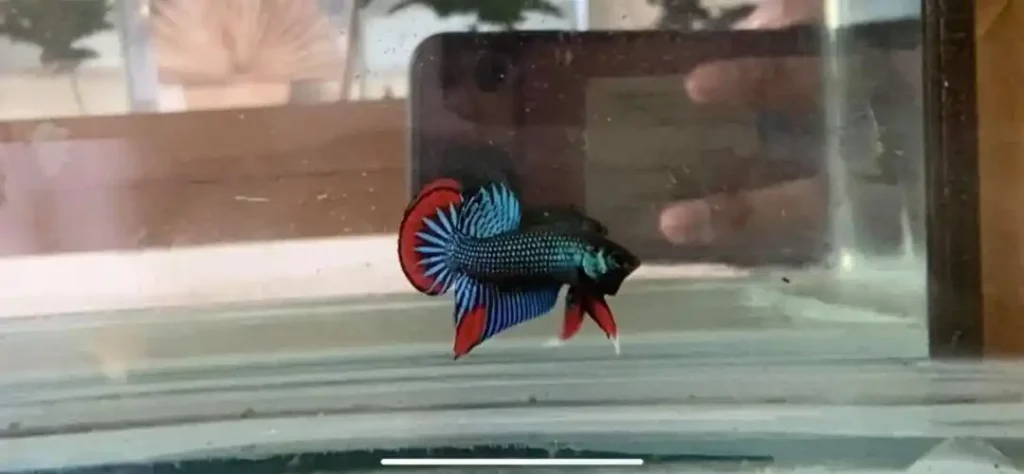Introduction
You came to know Betta Imbellis, a Betta fish breed. You may own a Betta Imbellis or are thinking of owning one. Whatever the reason, if you are looking for a proper guide about Betta Imbellis, you are at the right place.
This article will go through “Betta Imbellis: “The Peaceful Betta” Care Guide” Origin, History, Personality, Care, breeding, and much more. So, let’s dive into it.

Origin Of Betta Imbellis
Betta Imbellis, also known as “The Peaceful Betta,“ has a rich history that dates back to the early 20th century. They originate from the freshwater bodies of Southeast Asia Islands, particularly Thailand, Malaysia, and Indonesia, where they survive in slow-moving water bodies like rice paddies, swamps, ponds, and shallow streams with good vegetation.
Betta Imbellis Habitat
Betta Imbellis is comfortable staying in slow-moving, sluggish water bodies such as rice paddies, swamps, and shallow streams with a substrate composed of leaf litter and mud. They are often surrounded by marginal vegetation that sometimes contains little dissolved oxygen.
These environments are ideal conditions for Betta Imbellis, providing hiding spots and breeding grounds. Their natural habitats are crucial for maintaining wild populations. Human activities like agriculture and urbanization pose significant threats to their ecosystems.
Betta Imbellis Appearance and Characteristics
Physical Characteristics
Betta Imbellis are smaller and less flamboyant than Betta Splendens. They have sleek bodies with attractive, long, flowing fins that can extend to impressive lengths, adding to their majestic appearance to their grace.
Colors
Their stunning and diverse colors characterize Betta Imbellis. Their colors range from vibrant hues to shades of blue, green, red, black, and brown, with iridescent scales that shimmer under good lighting conditions.
Size
Betta Imbellis are typically relatively smaller in size compared to other betta species. They grow about 2 to 2.5 inches (5 to 6.4 cm) in length, making them a compact and ideal choice for addition to aquarium setups.
Life Span
Betta Imbellis, with proper care and an ideal environment, can live up to 3-5 years in captivity.
Sexual Dimorphism
Betta Imbellis is a sexual dimorphism, which means the male and female have different sizes and colors. Males are more vibrant and have longer fins compared to females, which are generally smaller and less colorful.
Males display stronger and brighter colors on their scales and also have longer fins. On the other hand, females have more of a drab brown color, where they display an ovipositor(white spot) near the ventral fin.
The Unique Personality of Betta Imbellis
The Imbellis from Betta Imbellis name came from the Latin word ‘peaceful.’ Unlike their more aggressive other Betta species, Betta Imbellis are known for their peaceful and docile nature. They have gained a reputation for their peaceful nature, making them a preferred choice of pet.
Betta Imbellis are curious and interactive fish. They display a willingness to engage with their human caretakers. However, it’s important to note that while they are generally peaceful, they may still exhibit territorial behaviors and should be housed accordingly.

Are Betta Imbellis Truly Peaceful?
Betta Imbellis are known for their calm nature compared to other Betta fish breeds. Yet male Betta Imbellis are territorial in nature, so they may exhibit aggression, especially during breeding seasons. However, they are far less aggressive compared to other Betta breeds.
Betta Imbellis vs. Other Betta Breeds
While Betta Imbellis shares many similarities with other Betta species, yet some key differences set them apart. Betta Imbellis, compared to Betta Splendens, share a similar bloodline but have significantly different temperaments.
Betta Splendens, or Siamese fighting fish, are known for their aggression, while Betta Imbellis are much more calm and docile. Betta Imbellis are more likely to coexist peacefully with other tankmates, whereas Betta Splendens often require solitary setups.
Among all the Betta fish species, do you know which is The Most Expensive Betta Fish In The World?
Wild Betta Imbellis vs. Domestic Betta Imbellis
Wild Betta Imbellis have an adaptive nature to a wide range of water conditions and thrive in their natural habitats. In the case of domestic Betta Imbellis, they have adapted to captive environments with more specific care requirements.
Domestic Betta Imbellis are more familiar with human interaction and less stressed in aquarium settings. Understanding the differences in behavior, appearance, and care requirements between wild and domestic Betta Imbellis can help ensure their optimal well-being in aquarium settings.

Betta Imbellis Care Guide
Just like other Betta breeds, Betta Imbellis also needs proper care. There are various aspects that must be kept in mind for Betta Imbellis to have a healthy and prolonged life.
Tank Size and Setup
Betta Imbellis are known for their peaceful behavior and calmness but male Betta Imbellis are territorial and may show aggression during breeding season. Therefore a minimum of 10 gallons is recommended for Betta Imbellis, providing enough space for them to swim and explore.
Environment
To make a comfortable living for Betta Imbellis, replicate their natural habitat with plenty of plants, driftwood, and hiding spots. Providing proper lighting and a soft substrate is also ideal.
Water Condition
Betta Imbellis are tropical fish, so they maintain a water temperature between 75-80°F and a pH level of 6.0-7.5. Regular water changes and cleaning should be practiced to keep the water quality high.
Filtration
A gentle filtration system will be helpful to maintain a clean environment for Betta Imbellis and avoid strong currents that can stress the fish.
Diet
Betta Imbellis are omnivorous, and in the wild, they feed on a wide range of small water bodies like algae, daphnia, brine shrimps, bloodworms, artemia, etc.
Captimates require high-quality betta pellets, live or frozen foods like brine shrimp and bloodworms, and occasional vegetable matter, which are ideal.
Tank Mates
As we know now, Betta Imbellis are territorial in nature, so make sure you choose peaceful tank mates like small tetras, rasboras, and corydoras. Avoid aggressive or fin-nipping species.
Betta Imbellis Breeding Guide
Betta Imbellis breeding is a rewarding and fascinating experience for aquarium enthusiasts. There are various processes and aspects of Betta Imbellis breeding.

Breeding Conditions
Set up a separate breeding tank with plenty of plants and hiding spots during the breeding season. Maintain the water temperature between 75-80°F and a pH level of 6.0-7.5 to encourage spawning.
Breeding Process
Gradually introduce the female Betta Imbellis to the male’s tank. Allow them to interact slowly and observe their activities. Make sure they both are compatible with each other.
If they both show any sign of aggression, separate them immediately. Wait a day or so and retry the process until they become compatible.
Bubble Nests
Before the female Betta Imbellis lays eggs, the male Betta Imbellis creates a floating bubble nest. The female will lay her eggs between the bubble nest, providing a safe environment for the developing fry.
Spawning
Once the female Betta Imbellis lays her eggs, the male Betta Imbellis collects them and places them in the bubble nest for protection. After spawning, it’s best to remove the female Betta Imbellis from the male tank to prevent aggression.
Raising Fry
After the female Betta Imbellis lays the eggs, the male Betta Imbellis guards the nest until the eggs hatch which typically takes 24-36 hours. Once the fry starts free swimming, the male Betta Imbellis should be removed to another tank.
Feed the fry infusoria or commercially prepared fry food until they are large enough to eat normal diet as their parents.

Conclusion
Betta Imbellis: The Peaceful Betta offers a unique and rewarding aquarium experience for fish enthusiasts. With its stunning colors and serene nature, the Betta Imbellis is a species worth exploring and cherishing. Whether you are a professional fish keeper or a newbie, “Betta Imbellis: “The Peaceful Betta” Care Guide” provides a complete look at understanding their origins, characteristics, appearance, personality, care, breeding requirements, and much more.
By following these guidelines, you can ensure the best care for Betta Imbellis, “The Peaceful Betta,” and maintain their longevity. Remember: A Healthy Betta Is A Happy Betta.
Frequently Asked Questions
Q: Are Betta Imbellis truly peaceful compared to other betta species?
A: Yes, Betta Imbellis are peaceful compared to their cousins but the male Betta Imbellis are territorial in nature.
Q: What are the key differences between Betta Imbellis and Betta Splendens?
A: Betta Imbellis is generally more peaceful and less aggressive than Betta Splendens. They both possess different personalities and color combinations.
Q: How do I set up the ideal habitat for my Betta Imbellis?
A: Set up a tank of at least 10 gallons with a temperature of 75-82°F, pH between 6.0 and 7.5, gentle filtration, and plenty of live plants and hiding spots.
Q: What should I feed my Betta Imbellis, and how often?
A: Feed your Betta Imbellis a varied diet of high-quality betta pellets, live or frozen foods like brine shrimp, and bloodworms, twice a day in small amounts.
Q: Can Betta Imbellis be kept with other tank mates?
A: Yes, Betta Imbellis can be kept with small, peaceful fish such as rasboras, tetras, and small catfish, avoiding fin-nipping or aggressive species.
Q: What are the challenges in breeding Betta Imbellis, and how can I overcome them?
A: Challenges include ensuring the male builds a bubble nest and proper care for the fry; overcome these by providing a separate breeding tank with optimal conditions and monitoring the breeding process closely.
Q: How can I identify the sex of my Betta Imbellis?
A: Males typically have brighter colors and longer fins, while females are smaller with shorter fins and less vivid coloration.
Q: What are the common health issues that Betta Imbellis may face, and how can I address them?
A: Common health issues include ich, fin rot, and fungal infections; address these by maintaining good water quality, performing regular water changes, and observing for any signs of illness to treat promptly.
Q: Are there any special considerations when keeping wild-caught Betta Imbellis compared to domestic ones?
A: Wild-caught Betta Imbellis may require more specific water conditions mimicking their natural habitat and may be more prone to stress, so provide a well-planted, quiet tank environment.
Q: How can I contribute to the conservation of Betta Imbellis in their natural habitats?
A: Support conservation efforts by purchasing captive-bred fish, advocating for the preservation of their natural habitats, and supporting organizations working on conservation projects.
Q: How often should I clean the tank?
A: Perform partial water changes of about 25% every week to maintain water quality. Regularly check and clean the filter, and remove any uneaten food and waste to prevent ammonia buildup.
Q: What is the ideal water temperature for Betta Imbellis?
A: The ideal water temperature for Betta Imbellis is between 75-80°F. Use a reliable heater to maintain a consistent temperature within this range.
Q: How can I tell if my Betta Imbellis is healthy?
A: A healthy Betta Imbellis will be active, have vibrant colors, clear eyes, and well-formed fins. They should show interest in food and interact with their environment. Signs of illness include lethargy, faded colors, clamped fins, and loss of appetite.
Q: What is Betta imbellis?
A: Betta imbellis, commonly known as the Peaceful Betta or Crescent Betta, is a species of freshwater fish from the Betta genus. They are known for their more peaceful temperament compared to the Betta splendens (Siamese fighting fish).
Q: What is the natural habitat of Betta imbellis?
A: Betta Imbellis is native to the slow-moving waters of Southeast Asia, particularly in Thailand and Malaysia. They thrive in shallow, vegetated waters such as swamps, rice paddies, and canals.
Q: What is the lifespan of Betta imbellis?
A: With proper care, Betta imbellis can live for 3 to 5 years.
Q: Are Betta Imbellis prone to any specific diseases?
A: Betta Imbellis can be susceptible to common freshwater fish diseases such as ich, fin rot, and fungal infections. Maintaining good water quality and a stress-free environment helps prevent these issues.
You May Also Checkout:

